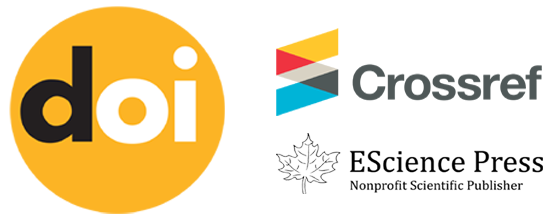
Sponsoring Member – CrossRef
EScience Press is a sponsoring member of CrossRef and offers
-
CrossRef DOI – Facilitate content registration with Crossref on behalf of sponsored members/organizations
-
Similarity Check – Plagiarism check through iThenticate screening
-
Crossmark – Crossmark gives readers quick and easy access to the current status of a piece of content. With one click, you can see if content has been updated, corrected or retracted and access valuable additional metadata provided by the publisher
Contact info@esciencepress.net or info@doi.org.pk for sponsored member service/s.
What is digital object identifier, or DOI?
A digital object identifier (DOI) is a unique alphanumeric string assigned by a registration agency (the International DOI Foundation) to identify content and provide a persistent link to its location on the Internet. The publisher assigns a DOI when your article is published and made available electronically.
DOIs makes research outputs easy to find, cite, link, assess and make scholarly communications better.
CrossRef is a DOI registration agency offers different services to its members.
Information on DOI, CrossRef content registration and the Sponsoring Organizations can be found on the links given below;
https://en.wikipedia.org/wiki/Digital_object_identifier
https://www.crossref.org/get-started/
https://esciencepress.net/crossref-doi/
What is CrossRef – CrossMark?
Crossmark gives readers quick and easy access to the current status of an item of content. With one click, you can see if content has been updated, corrected or retracted and access valuable additional metadata provided by the publisher.
Benefits
-
Publishers can reassure readers that they’re keeping their content up-to-date and showcase additional metadata.
-
Researchers and librarians can easily see the changes to the content they are reading, find out who funded the research, what licenses apply to the content and more.
-
Anyone can access the Crossmark metadata through our REST API, providing a myriad of opportunities for integration with other systems and analysis of changes to the scholarly record .
How it Works
Publishers place the Crossmark button close to the title of an item of content on their web pages and in PDFs and commit to informing us if there is an update such as a correction or retraction. They also send additional metadata such as authors’ ORCIDs and the funders behind the research.
When a reader clicks on the button a pop-up box appears that headlines the current status of the content: up-to-date, updates available, or retracted, and also displays all of the additional information. Watch the video below to find out more: How to participate Publishers participate in Crossmark by depositing additional metadata for their content and adding a snippet of code to their DOI landing pages to generate the Crossmark button and link. Find out more about how to get started.
More information about CrossMark can be found at;
https://www.crossref.org/services/crossmark/
What is Similarity Check?
For editorial originality, Similarity Check helps editors compare the text of submitted papers for similarity.
Similarity Check is a service for editors who want an extra check. The service helps our members to actively engage in efforts to prevent scholarly and professional plagiarism by providing their editorial teams with access to Turnitin’s powerful text comparison tool, iThenticate.
Benefits
While there are several plagiarism screening tools available, Similarity Check participants enjoy cost-effective use of iThenticate because they contribute their own published content into Turnitin’s database of full-text literature. This means that as the number of participants grows, so too does the size of the database powering the service. More content in the database means greater peace of mind for editors looking to determine a manuscript’s originality.
Turnitin also provides our members with access to additional features in iThenticate, such as enhanced text-matches within the document viewer. And with access to Turnitin’s dedicated Similarity Check support team, our members always have a direct line to Turnitin in order to discuss any technical or billing queries.
How the Similarity Check service works?
In return for a reduced fee for access to iThenticate, Similarity Check subscribers allow Turnitin to index their full catalogue of current and archival published content as this ensures the highest level of text-matching accuracy. This means that the service is only available to members who are actively publishing DOI-assigned content and including full-text URLs in their metadata which Turnitin can access.
Turnitin index members’ content directly via their Content Intake System. Their CIS accesses our metadata daily to collect the full-text content links provided by our members within their DOI deposit metadata. Turnitin follow these URLs and index the content found at each location.
On application to join the service, members must ensure they have full-text URLs present in the metadata of at least 90% of their registered articles (across all the member’s journal prefixes, as applicable). These URLs need to point directly to the full-text PDF, HTML or plain text content. Members must also ensure that these links are included in all future deposits too.
Please note that the metadata which members deposit with Crossref is available to be searched and retrieved by everyone, and this includes Similarity Check URLs. If your content is paywalled, please make sure that your Similarity Check URLs prompt an authentication step before allowing a user to access full-text content. You’ll need to ensure that your hosting provider has whitelisted Turnitin’s IP range to ensure the content is accessible for Turnitin to index.
Once members meet the eligibility criteria for Similarity Check, members will be provided with access to iThenticate. Using iThenticate, members will be able to upload their own manuscripts to compare against the full corpus of published academic and general web content in Turnitin’s database. iThenticate provides a similarity score and a highlighted set of matches to similar text. Editors can then further review matches in order to make their own decision regarding a manuscript’s originality.
More information about Similarity Check can be found at;
https://www.crossref.org/services/similarity-check/




